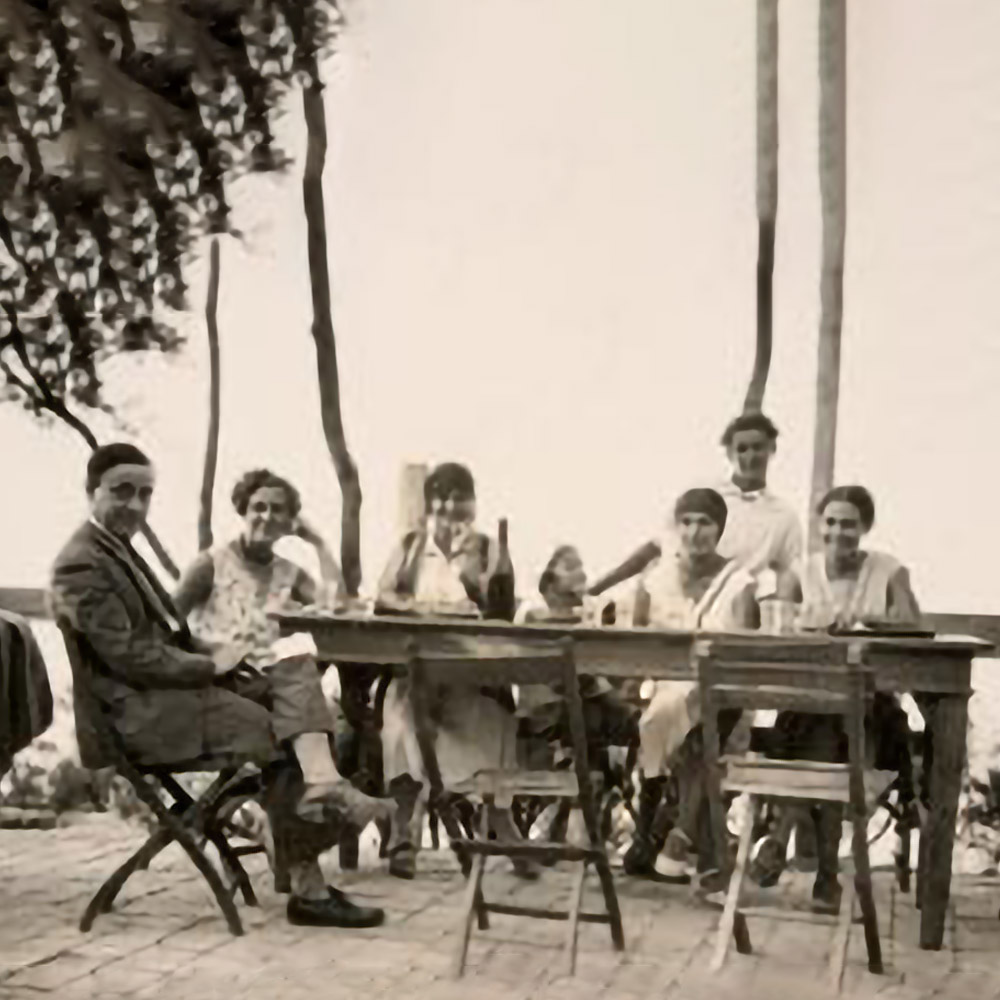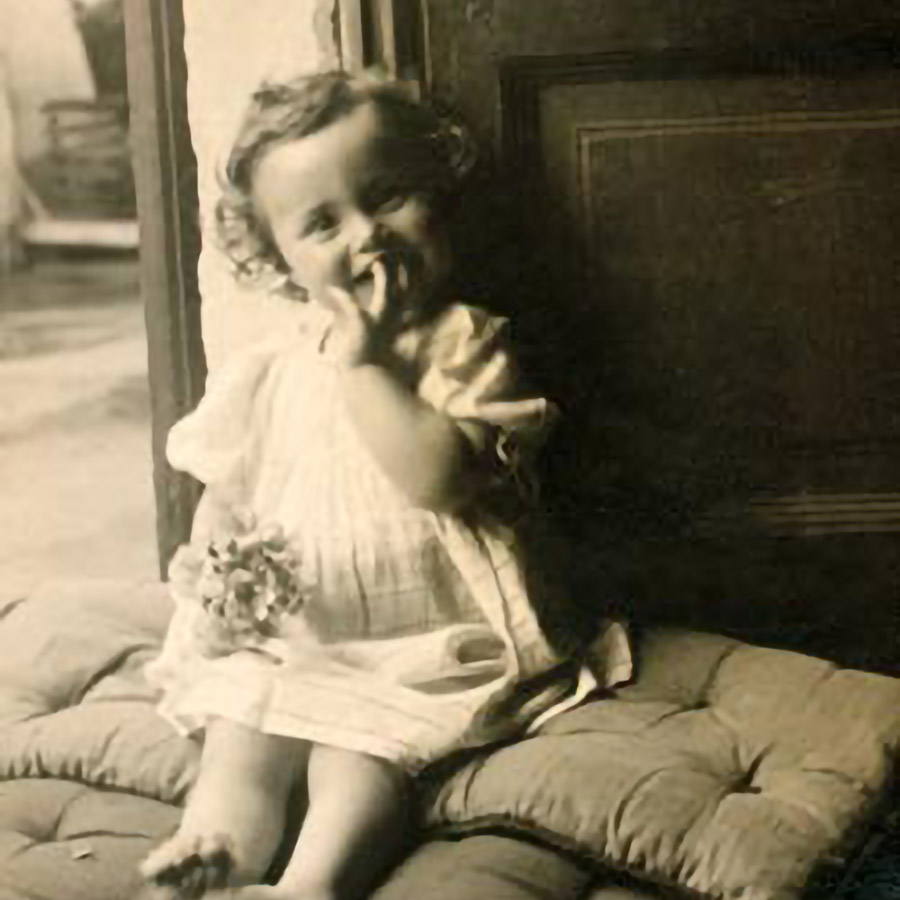Album di famiglia n.1
The images that follow each other in this album
of photographs of people, they belong to years when I was not yet born, except for the last one dated 1939. There I was an eight-year-old boy, pretending to lick an ice cream from a cone that was instead empty, I was with my sister Maria, and my cousin Rita, and our aunt Marieda, director of the funny performance. We were at the beach in Riccione, on the sand, sitting on a moscone. An aunt who invented them all. Happy times. A photo album: so many faces and so many faded, distant and blurred figures, but emerging perfectly in my memory with their physiognomies and characters. They are, as young people, the many members of my family that I got to know later, when they were old or grown up: my family before my family, the value and weight of ancestors.
To look through the stories and anecdotes of this past, then, is an exercise I rarely do, it is for me an overly romantic and even somewhat distressing activity. Yet I am the fruit of these things, and the photographs in this album express ghosts of lives, testimonies of joys, sorrows, cultures and customs. Looked at by an outside observer, these many partly Art Nouveau, partly deco and partly rationalist people, in their clothes and hairstyles, become period documents in their motionless and definitive poses. The first thirty years of the last century: the First World War, Fascism and anti-Fascism, songs, Milan and its much-troubled bourgeoisie. Cesare, Mariuccia, Antonio, Lisetta, Vincenzo, Fulvia, Zizzetta, Marco, Agostino, grandmother Mariettina.
Grandfather Chicchì (Francesco Di Stefano) was the one who wanted and built the building on via Giorgio Jan in 1930, for himself and each of his children. Then the arrival of husbands for the daughters, among them the engineer from Novara Antonio Boschi for Marieda, and the Veronese lawyer Vincenzo Mendini for Fulvia (my mother). They are the actors in the lives that intertwine in the family before the existence of me and the building, and then within it, even with me. Cousins, uncles, brothers, sons-in-law, daughters-in-law, friends, lawyers, engineers, chemists, and so on. I was born in Jan Street in 1931.


Il nonno Francesco aveva commissionato il progetto della casa a Piero Portaluppi, e dalla cura con cui è stata disegnata si riconosce l’intesa profonda che i due ebbero nell’inventare questa mirabile dimora, una delle più raffinate dell’architetto. Portaluppi la chiamava “villa” e la chiara ispirazione arrivava dalla secessione viennese e dall’architettura alpina. A quei tempi via Jan era un prato fuori porta, e la casa sorgeva isolata, un po’ metafisica. Fu il nonno Francesco ad iniziare lì dentro una collezione di quadri, con alcune notevoli opere di Tosi, Ubaldo Oppi, Funi (Il marinaio), Sironi (I costruttori), Casorati (Una fanciulla). Fu perciò lui a far conoscere agli zii Antonio e Marieda i primi artisti ed a provocare in loro lo stesso contagio. A quei tempi lo zio Boschi non era ancora quell’alto dirigente della Pirelli e quell’infaticabile inventore di brevetti “gomma-ferro” che divenne dopo. Era un giovane appena laureato che, con la assoluta complicità della moglie, faceva ogni sacrificio pur di frequentare gallerie come quella del Milione, e di portarsi a casa un piccolo Carrà o una statuina di Arturo Martini. Marieda estroversa, bella, generosa, mondana, elegante e creativa era la perfetta seduttrice anche dei pittori più difficili, come ad esempio Morandi o Savinio. Era un mondo protetto e protettivo, per me bambino un po’ sogno e un po’ incubo, dove vigeva il piacere dell’intesa umana, della scoperta, del documento, delle capacità di scelta e di contatto. Le porte di tutti i nostri appartamenti di solito erano aperte, e la scala era come un soggiorno comune. Noi nipoti vivevamo sempre in quelle stanze anche un po’ kitsch, troppo piene anche di gatti e di cineserie, quell’atmosfera era il nostro luogo, si giocava sotto le tre gambe del Beckstein. In casa c’erano delle scalette, chiodi e un martello, e collocare un nuovo quadro significava spesso per lo zio modificare il puzzle interminabile di una intera parete, guadagnando centimetri, cornice contro cornice, per intere notti. Marieda cultrice e scultrice di ceramica, Antonio maestro di violino e colonnello nei dirigibili, nel loro lungo e solare matrimonio non ebbero figli. Gli eventi e i destini di tanti anni e generazioni successive hanno poi modificato molte cose, ognuna delle figure di queste immagini ha svolto e intrecciato il suo romanzo personale. La seconda guerra e lo sfollamento, il freddo, le paure, i partigiani, la fuga in campagna anche della collezione, appartengono ai prossimi due album di fotografie, che sono in programma.
Alessandro Mendini
